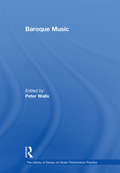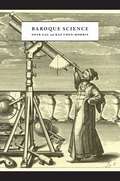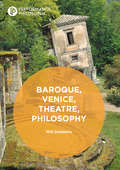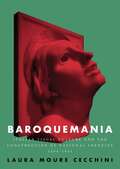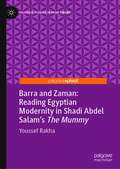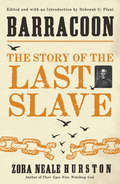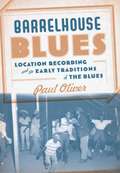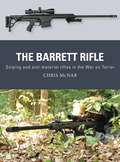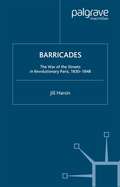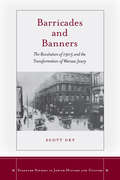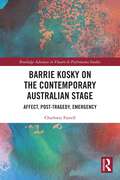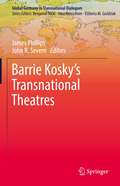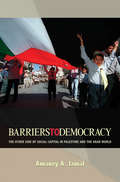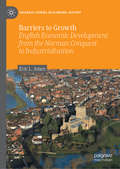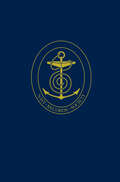- Table View
- List View
Baroque Music
by Peter WallsResearch in the 20th and 21st centuries into historical performance practice has changed not just the way performers approach music of the 17th and 18th centuries but, eventually, the way audiences listen to it. This volume, beginning with a 1915 Saint-Sa lecture on the performance of old music, sets out to capture musicological discussion that has actually changed the way Baroque music can sound. The articles deal with historical instruments, pitch, tuning, temperament, the nexus between technique and style, vibrato, the performance implications of musical scores, and some of the vexed questions relating to rhythmic alteration. It closes with a section on the musicological challenges to the ideology of the early music movement mounted (principally) in the 1990s. Leading writers on historical performance practice are represented. Recognizing that significant developments in historically-inspired performance have been led by instrument makers and performers, the volume also contains representative essays by key practitioners.
Baroque Science
by Ofer Gal Raz Chen-MorrisIn Baroque Science, Ofer Gal and Raz Chen-Morris present a radically new perspective on the scientific revolution of the seventeenth century. Instead of celebrating the triumph of reason and rationality, they study the paradoxes and anxieties that stemmed from the New Science and the intellectual compromises that shaped it and enabled its spectacular success. Gal and Chen-Morris show how the protagonists of the new mathematical natural philosophy grasped at the very far and very small by entrusting observation to the mediation of artificial instruments, and how they justified this mediation by naturalizing and denigrating the human senses. They show how the physical-mathematical ordering of heavens and earth demanded obscure and spurious mathematical procedures, replacing the divine harmonies of the late Renaissance with an assemblage of isolated, contingent laws and approximated constants. Finally, they show how the new savants, forced to contend that reason is hopelessly estranged from its surrounding world and that nature is irreducibly complex, turned to the passions to provide an alternative, naturalized foundation for their epistemology and ethics. Enforcing order in the face of threatening chaos, blurring the boundaries of the natural and the artificial, and mobilizing the passions in the service of objective knowledge, the New Science, Gal and Chen-Morris reveal, is a Baroque phenomenon: deeply entrenched in and crucially formative of the culture of its time.
Baroque Science
by Ofer Gal Raz Chen-MorrisIn Baroque Science, Ofer Gal and Raz Chen-Morris present a radically new perspective on the scientific revolution of the seventeenth century. Instead of celebrating the triumph of reason and rationality, they study the paradoxes and anxieties that stemmed from the New Science and the intellectual compromises that shaped it and enabled its spectacular success. Gal and Chen-Morris show how the protagonists of the new mathematical natural philosophy grasped at the very far and very small by entrusting observation to the mediation of artificial instruments, and how they justified this mediation by naturalizing and denigrating the human senses. They show how the physical-mathematical ordering of heavens and earth demanded obscure and spurious mathematical procedures, replacing the divine harmonies of the late Renaissance with an assemblage of isolated, contingent laws and approximated constants. Finally, they show how the new savants, forced to contend that reason is hopelessly estranged from its surrounding world and that nature is irreducibly complex, turned to the passions to provide an alternative, naturalized foundation for their epistemology and ethics. Enforcing order in the face of threatening chaos, blurring the boundaries of the natural and the artificial, and mobilizing the passions in the service of objective knowledge, the New Science, Gal and Chen-Morris reveal, is a Baroque phenomenon: deeply entrenched in and crucially formative of the culture of its time.
Baroque Science
by Ofer Gal Raz Chen-MorrisIn Baroque Science, Ofer Gal and Raz Chen-Morris present a radically new perspective on the scientific revolution of the seventeenth century. Instead of celebrating the triumph of reason and rationality, they study the paradoxes and anxieties that stemmed from the New Science and the intellectual compromises that shaped it and enabled its spectacular success. Gal and Chen-Morris show how the protagonists of the new mathematical natural philosophy grasped at the very far and very small by entrusting observation to the mediation of artificial instruments, and how they justified this mediation by naturalizing and denigrating the human senses. They show how the physical-mathematical ordering of heavens and earth demanded obscure and spurious mathematical procedures, replacing the divine harmonies of the late Renaissance with an assemblage of isolated, contingent laws and approximated constants. Finally, they show how the new savants, forced to contend that reason is hopelessly estranged from its surrounding world and that nature is irreducibly complex, turned to the passions to provide an alternative, naturalized foundation for their epistemology and ethics. Enforcing order in the face of threatening chaos, blurring the boundaries of the natural and the artificial, and mobilizing the passions in the service of objective knowledge, the New Science, Gal and Chen-Morris reveal, is a Baroque phenomenon: deeply entrenched in and crucially formative of the culture of its time.
Baroque Science
by Ofer Gal Raz Chen-MorrisIn Baroque Science, Ofer Gal and Raz Chen-Morris present a radically new perspective on the scientific revolution of the seventeenth century. Instead of celebrating the triumph of reason and rationality, they study the paradoxes and anxieties that stemmed from the New Science and the intellectual compromises that shaped it and enabled its spectacular success. Gal and Chen-Morris show how the protagonists of the new mathematical natural philosophy grasped at the very far and very small by entrusting observation to the mediation of artificial instruments, and how they justified this mediation by naturalizing and denigrating the human senses. They show how the physical-mathematical ordering of heavens and earth demanded obscure and spurious mathematical procedures, replacing the divine harmonies of the late Renaissance with an assemblage of isolated, contingent laws and approximated constants. Finally, they show how the new savants, forced to contend that reason is hopelessly estranged from its surrounding world and that nature is irreducibly complex, turned to the passions to provide an alternative, naturalized foundation for their epistemology and ethics. Enforcing order in the face of threatening chaos, blurring the boundaries of the natural and the artificial, and mobilizing the passions in the service of objective knowledge, the New Science, Gal and Chen-Morris reveal, is a Baroque phenomenon: deeply entrenched in and crucially formative of the culture of its time.
Baroque Science
by Ofer Gal Raz Chen-MorrisIn Baroque Science, Ofer Gal and Raz Chen-Morris present a radically new perspective on the scientific revolution of the seventeenth century. Instead of celebrating the triumph of reason and rationality, they study the paradoxes and anxieties that stemmed from the New Science and the intellectual compromises that shaped it and enabled its spectacular success. Gal and Chen-Morris show how the protagonists of the new mathematical natural philosophy grasped at the very far and very small by entrusting observation to the mediation of artificial instruments, and how they justified this mediation by naturalizing and denigrating the human senses. They show how the physical-mathematical ordering of heavens and earth demanded obscure and spurious mathematical procedures, replacing the divine harmonies of the late Renaissance with an assemblage of isolated, contingent laws and approximated constants. Finally, they show how the new savants, forced to contend that reason is hopelessly estranged from its surrounding world and that nature is irreducibly complex, turned to the passions to provide an alternative, naturalized foundation for their epistemology and ethics. Enforcing order in the face of threatening chaos, blurring the boundaries of the natural and the artificial, and mobilizing the passions in the service of objective knowledge, the New Science, Gal and Chen-Morris reveal, is a Baroque phenomenon: deeply entrenched in and crucially formative of the culture of its time.
Baroque Science
by Ofer Gal Raz Chen-MorrisIn Baroque Science, Ofer Gal and Raz Chen-Morris present a radically new perspective on the scientific revolution of the seventeenth century. Instead of celebrating the triumph of reason and rationality, they study the paradoxes and anxieties that stemmed from the New Science and the intellectual compromises that shaped it and enabled its spectacular success. Gal and Chen-Morris show how the protagonists of the new mathematical natural philosophy grasped at the very far and very small by entrusting observation to the mediation of artificial instruments, and how they justified this mediation by naturalizing and denigrating the human senses. They show how the physical-mathematical ordering of heavens and earth demanded obscure and spurious mathematical procedures, replacing the divine harmonies of the late Renaissance with an assemblage of isolated, contingent laws and approximated constants. Finally, they show how the new savants, forced to contend that reason is hopelessly estranged from its surrounding world and that nature is irreducibly complex, turned to the passions to provide an alternative, naturalized foundation for their epistemology and ethics. Enforcing order in the face of threatening chaos, blurring the boundaries of the natural and the artificial, and mobilizing the passions in the service of objective knowledge, the New Science, Gal and Chen-Morris reveal, is a Baroque phenomenon: deeply entrenched in and crucially formative of the culture of its time.
Baroque, Venice, Theatre, Philosophy
by Will DaddarioThis book theorizes the baroque as neither a time period nor an artistic style but as a collection of bodily practices developed from clashes between governmental discipline and artistic excess, moving between the dramaturgy of Jesuit spiritual exercises, the political theatre-making of Angelo Beolco (aka Ruzzante), and the civic governance of the Venetian Republic at a time of great tumult. The manuscript assembles plays seldom read or viewed by English-speaking audiences, archival materials from three Venetian archives, and several secondary sources on baroque, Renaissance, and early modern epistemology in order to forward and argument for understanding the baroque as a gathering of social practices. Such a rethinking of the baroque aims to complement the already lively studies of neo-baroque aesthetics and ethics emerging in contemporary scholarship on (for example) Latin American political art.
Baroque, Venice, Theatre, Philosophy
by Will DaddarioThis book theorizes the baroque as neither a time period nor an artistic style but as a collection of bodily practices developed from clashes between governmental discipline and artistic excess, moving between the dramaturgy of Jesuit spiritual exercises, the political theatre-making of Angelo Beolco (aka Ruzzante), and the civic governance of the Venetian Republic at a time of great tumult. The manuscript assembles plays seldom read or viewed by English-speaking audiences, archival materials from three Venetian archives, and several secondary sources on baroque, Renaissance, and early modern epistemology in order to forward and argument for understanding the baroque as a gathering of social practices. Such a rethinking of the baroque aims to complement the already lively studies of neo-baroque aesthetics and ethics emerging in contemporary scholarship on (for example) Latin American political art.
Baroquemania: Italian visual culture and the construction of national identity, 1898–1945
by Laura Moure CecchiniBaroquemania explores the intersections of art, architecture and criticism to show how reimagining the Baroque helped craft a distinctively Italian approach to modern art. Offering a bold reassessment of post-unification visual culture, the book examines a wide variety of media and ideologically charged discourses on the Baroque, both inside and outside the academy. Key episodes in the modern afterlife of the Baroque are addressed, notably the Decadentist interpretation of Gianlorenzo Bernini, the 1911 universal fairs in Turin and Rome, Roberto Longhi’s historically grounded view of Futurism, architectural projects in Fascist Rome and the interwar reception of Adolfo Wildt and Lucio Fontana’s sculpture. Featuring a wealth of visual materials, Baroquemania offers a fresh look at a central aspect of Italy's modern art.
Baroquemania: Italian visual culture and the construction of national identity, 1898–1945
by Laura Moure CecchiniBaroquemania explores the intersections of art, architecture and criticism to show how reimagining the Baroque helped craft a distinctively Italian approach to modern art. Offering a bold reassessment of post-unification visual culture, the book examines a wide variety of media and ideologically charged discourses on the Baroque, both inside and outside the academy. Key episodes in the modern afterlife of the Baroque are addressed, notably the Decadentist interpretation of Gianlorenzo Bernini, the 1911 universal fairs in Turin and Rome, Roberto Longhi’s historically grounded view of Futurism, architectural projects in Fascist Rome and the interwar reception of Adolfo Wildt and Lucio Fontana’s sculpture. Featuring a wealth of visual materials, Baroquemania offers a fresh look at a central aspect of Italy's modern art.
Barra and Zaman: Reading Egyptian Modernity in Shadi Abdel Salam’s The Mummy (Palgrave Studies in Arab Cinema)
by Youssef RakhaBrilliantly introduced by Nezar Andary, this book is a work of creative nonfiction that approaches writing on film in a fresh and provocative way. It draws on academic, literary, and personal material to start a dialogue with the Egyptian filmmaker Shadi Abdel Salam’s The Mummy (1969), tracing the many meanings of Egypt’s postcolonial modernity and touching on Arab, Muslim, and ancient Egyptian identities through watching the film.
Barracoon: The Story Of The Last "black Cargo"
by Zora Neale HurstonAbducted from Africa, sold in America. “A deeply affecting record of an extraordinary life”- Daily Telegraph A major literary event: a newly published work from the author of the American classic Their Eyes Were Watching God, with a foreword from Pulitzer Prize-winning author Alice Walker.
Barrelhouse Blues: Location Recording and the Early Traditions of the Blues
by Paul OliverIn the 1920s, Southern record companies ventured to cities like Dallas, Atlanta, and New Orleans, where they set up primitive recording equipment in makeshift studios. They brought in street singers, medicine show performers, pianists from the juke joints and barrelhouses. The music that circulated through Southern work camps, prison farms, and vaudeville shows would be lost to us if it hadn't been captured on location by these performers and recorders.Eminent blues historian Paul Oliver uncovers these folk traditions and the circumstances under which they were recorded, rescuing the forefathers of the blues who were lost before they even had a chance to be heard. A careful excavation of the earliest recordings of the blues by one of its foremost experts, Barrelhouse Blues expands our definition of that most American style of music.
The Barrett Rifle: Sniping and anti-materiel rifles in the War on Terror (Weapon)
by Johnny Shumate Chris McNab Alan GillilandThe Barrett M82A1 and its derivatives are among the most successful sniping rifles ever manufactured. Now entering its fourth decade of service, the short-recoil, semi-automatic system is capable of firing a devastating .50-caliber round with lethal accuracy over distances of more than 2km. Unconfirmed reports from Afghanistan in 2012 accredit the Barrett with one of history's longest ever kills at 2,815m. This is the technical history of a rifle initially developed as a sporting firearm, but which evolved into a long-range sniping rifle and a formidable military anti-materiel tool, designed to neutralize everything from enemy vehicles to parked aircraft. Adopted by snipers across the world, the Barrett rifles have seen active service in Operation Desert Storm, Iraq, and Afghanistan and have become an important addition to police, armed services, and Special Forces units alike.
The Barrett Rifle: Sniping and anti-materiel rifles in the War on Terror (Weapon)
by Johnny Shumate Chris McNab Alan GillilandThe Barrett M82A1 and its derivatives are among the most successful sniping rifles ever manufactured. Now entering its fourth decade of service, the short-recoil, semi-automatic system is capable of firing a devastating .50-caliber round with lethal accuracy over distances of more than 2km. Unconfirmed reports from Afghanistan in 2012 accredit the Barrett with one of history's longest ever kills at 2,815m. This is the technical history of a rifle initially developed as a sporting firearm, but which evolved into a long-range sniping rifle and a formidable military anti-materiel tool, designed to neutralize everything from enemy vehicles to parked aircraft. Adopted by snipers across the world, the Barrett rifles have seen active service in Operation Desert Storm, Iraq, and Afghanistan and have become an important addition to police, armed services, and Special Forces units alike.
Barricades: The War of the Streets in Revolutionary Paris, 1830-1848
by J. HarsinBetween 1830 and 1848, Paris was rocked by two successful revolutions, three failed insurrections, and seven serious assassination attempts against King Louis-Phillippe and his sons. The June Days of 1848 - the worst urban insurrection in history until that time - finally brought this period to a close. Using a wide variety of sources, including detailed court records and hundreds of depositions of witnesses and suspects, Jill Harsin examines revolutionary republicanism during the violent underground movement of the July Monarchy, and describes these events in vivid detail. The lives of 'ordinary men' are captured in their own words as Harsin illuminates the political aspirations of the working class. Harsin's original writing style and compelling discussions shed new light on the particular turbulence of this era, a period of disruption that stemmed from the contemporary working class codes of masculinity and honour.
Barricades and Banners: The Revolution of 1905 and the Transformation of Warsaw Jewry (Stanford Studies in Jewish History and Culture)
by Scott UryThis book examines the intersection of urban society and modern politics among Jews in turn of the century Warsaw, Europe's largest Jewish center at the time. By focusing on the tumultuous events surrounding the Revolution of 1905, Barricades and Banners argues that the metropolitanization of Jewish life led to a need for new forms of community and belonging, and that the ensuing search for collective and individual order gave birth to the new institutions, organizations, and practices that would define modern Jewish society and politics for the remainder of the twentieth century.
Barrie Kosky on the Contemporary Australian Stage: Affect, Post-Tragedy, Emergency (Routledge Advances in Theatre & Performance Studies)
by Charlotte FarrellThis is the first book-length study of Australian theatre productions by internationally-renowned director, Barrie Kosky. Now a prolific opera director in Europe, Barrie Kosky on the Contemporary Australian Stage accounts for the formative years of Kosky's career in Australia. This book provides in-depth engagements with select productions including The Dybbuk which Kosky directed with Gilgul theatre company in 1991, as well as King Lear (1998), The Lost Echo (2006), and Women of Troy (2008). Using affect theory as a prism through which these works are analysed, the book accounts for the director's particular engagement with – and radical departure from – classical tragedy in contemporary performance: what the book defines as Kosky's 'post-tragedies'. Theatre studies scholars and students, particularly those with interests in affect, contemporary performance, 'director's theatre', and tragedy, will benefit from Barrie Kosky on the Contemporary Australian Stage’s vivid engagement with Kosky's work: a director who has become a singular figure in opera and theatre of international critical acclaim.
Barrie Kosky on the Contemporary Australian Stage: Affect, Post-Tragedy, Emergency (Routledge Advances in Theatre & Performance Studies)
by Charlotte FarrellThis is the first book-length study of Australian theatre productions by internationally-renowned director, Barrie Kosky. Now a prolific opera director in Europe, Barrie Kosky on the Contemporary Australian Stage accounts for the formative years of Kosky's career in Australia. This book provides in-depth engagements with select productions including The Dybbuk which Kosky directed with Gilgul theatre company in 1991, as well as King Lear (1998), The Lost Echo (2006), and Women of Troy (2008). Using affect theory as a prism through which these works are analysed, the book accounts for the director's particular engagement with – and radical departure from – classical tragedy in contemporary performance: what the book defines as Kosky's 'post-tragedies'. Theatre studies scholars and students, particularly those with interests in affect, contemporary performance, 'director's theatre', and tragedy, will benefit from Barrie Kosky on the Contemporary Australian Stage’s vivid engagement with Kosky's work: a director who has become a singular figure in opera and theatre of international critical acclaim.
Barrie Kosky’s Transnational Theatres (Global Germany in Transnational Dialogues)
by James Phillips John R. SevernThis book, the first of its kind, surveys the career of the renowned Australian-German theatre and opera director Barrie Kosky. Its nine chapters provide multidisciplinary analyses of Barrie Kosky’s working practices and stage productions, from the beginning of his career in Melbourne to his current roles as Head of the Komische Oper Berlin and as a guest director in international demand. Specialists in theatre studies, opera studies, musical theatre studies, aesthetics, and arts administration offer in-depth accounts of Kosky’s unusually wide-ranging engagements with the performing arts – as a director of spoken theatre, operas, musicals, operettas, as an adaptor, a performer, a writer, and an arts manager. Further, this book includes contributions from theatre practitioners with first-hand experience of collaborating with Kosky in the 1990s, who draw on interviews with members of Gilgul, Australia’s first Jewish theatre company, to document this formative period in Kosky’s career. The book investigates the ways in which Kosky has created transnational theatres, through introducing European themes and theatre techniques to his Australian work or through bringing fresh voices to the national dialogue in Germany’s theatre landscape. An appendix contains a timeline and guide to Kosky’s productions to date.
Barriers to Democracy: The Other Side of Social Capital in Palestine and the Arab World (PDF)
by Amaney A. JamalDemocracy-building efforts from the early 1990s on have funneled billions of dollars into nongovernmental organizations across the developing world, with the U.S. administration of George W. Bush leading the charge since 2001. But are many such "civil society" initiatives fatally flawed? Focusing on the Palestinian West Bank and the Arab world, Barriers to Democracy mounts a powerful challenge to the core tenet of civil society initiatives: namely, that public participation in private associations necessarily yields the sort of civic engagement that, in turn, sustains effective democratic institutions. Such assertions tend to rely on evidence from states that are democratic to begin with. Here, Amaney Jamal investigates the role of civic associations in promoting democratic attitudes and behavioral patterns in contexts that are less than democratic. Jamal argues that, in state-centralized environments, associations can just as easily promote civic qualities vital to authoritarian citizenship--such as support for the regime in power. Thus, any assessment of the influence of associational life on civic life must take into account political contexts, including the relationships among associations, their leaders, and political institutions. Barriers to Democracy both builds on and critiques the multifaceted literature that has emerged since the mid-1990s on associational life and civil society. By critically examining associational life in the West Bank during the height of the Oslo Peace Process (1993-99), and extending her findings to Morocco, Egypt, and Jordan, Jamal provides vital new insights into a timely issue.
Barriers to Growth: English Economic Development from the Norman Conquest to Industrialisation (Palgrave Studies in Economic History)
by Eric L. JonesThis book deals sequentially with major impediments to economic growth and their slow dissolution. It is original and quite different from standard economic history, which has always sought for one prime mover of the industrial revolution after another. These supposed positive forces are usually depicted as novel and little reference is made to inertia. Instead the barriers dealt with here run, in the first section, from early misallocations of resources to nineteenth-century reforms which of their nature indicate the problems to be overcome. The second section deals with more physical impediments and shocks, such as floods and settlement fires. These too are ignored in ordinary treatments, which this book will supplement or even replace. It will be of interest to academic economic historians and practitioners of neighbouring subjects such as economists, historians, historical geographers, and of course their students.
The Barrington Papers: Vol. I
by D. Bonner-SmithSamuel Barrington (1729-1800), a son of the first Viscount Barrington, entered the Royal Navy in 1740. He was posted in 1747 and eventually was promoted to Admiral in 1787.Papers in the possession of Barrington’s collateral descendants form these two volumes and cover his naval career. They comprise order books (1747-71), a private letter book (1770-99), his journal and three bound documents relating to the Leeward Islands command (1778-79), some loose correspondence, and printed matter: the general sailing and fighting Instructions, two signal books, and instructions. None of Barrington’s public letter books survives.This includes Barrington’s negotiations at Tetuan to release British subjects held by the Barbary corsairs, and his cruising off the coast of Guinea where some Royal Navy captains had been personally profiting from commercial dealings including the transportation of slaves.Commanding the 60-gun Achilles, he served from 1757-59 off the coast of France, in 1760 under Captain the Hon John Byron destroying the fortifications of Louisbourg in North America, and in 1761 under Commodore Augustus Keppel in the operations against Belle-Île. From 1762 until the 1763 Treaty of Paris, he commanded the 74-gun Hero. From 1768, when he again took to sea, until 1778 when he received his flag, he saw service in the dispute with Spain over the Falkland Islands (1771) and in the Channel.
The Barrington Papers: Vol. I
by D. Bonner-SmithSamuel Barrington (1729-1800), a son of the first Viscount Barrington, entered the Royal Navy in 1740. He was posted in 1747 and eventually was promoted to Admiral in 1787.Papers in the possession of Barrington’s collateral descendants form these two volumes and cover his naval career. They comprise order books (1747-71), a private letter book (1770-99), his journal and three bound documents relating to the Leeward Islands command (1778-79), some loose correspondence, and printed matter: the general sailing and fighting Instructions, two signal books, and instructions. None of Barrington’s public letter books survives.This includes Barrington’s negotiations at Tetuan to release British subjects held by the Barbary corsairs, and his cruising off the coast of Guinea where some Royal Navy captains had been personally profiting from commercial dealings including the transportation of slaves.Commanding the 60-gun Achilles, he served from 1757-59 off the coast of France, in 1760 under Captain the Hon John Byron destroying the fortifications of Louisbourg in North America, and in 1761 under Commodore Augustus Keppel in the operations against Belle-Île. From 1762 until the 1763 Treaty of Paris, he commanded the 74-gun Hero. From 1768, when he again took to sea, until 1778 when he received his flag, he saw service in the dispute with Spain over the Falkland Islands (1771) and in the Channel.
